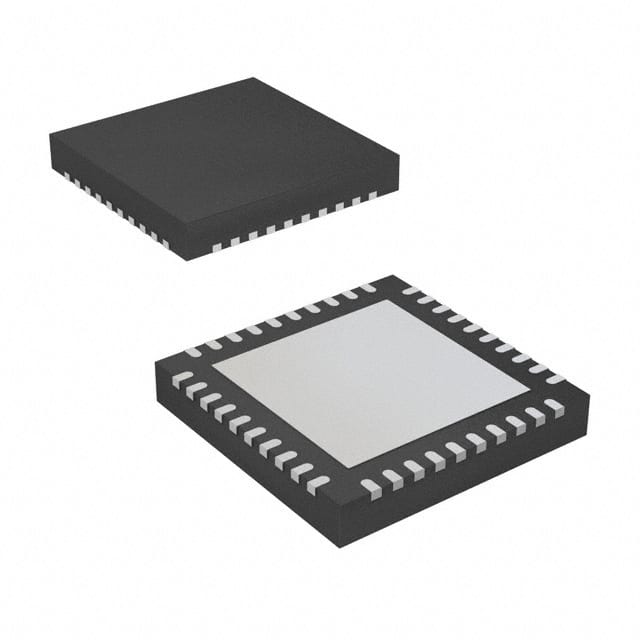PIC16F15375-I/MV
Introduction
The PIC16F15375-I/MV is a microcontroller belonging to the PIC16 family of microcontrollers produced by Microchip Technology. This entry provides an overview of the product, including its category, use, characteristics, package, essence, packaging/quantity, specifications, detailed pin configuration, functional features, advantages and disadvantages, working principles, detailed application field plans, and alternative models.
Basic Information Overview
- Category: Microcontroller
- Use: Embedded control applications
- Characteristics: Low power consumption, high performance, versatile peripherals
- Package: 20-pin SSOP (Shrink Small Outline Package)
- Essence: 8-bit microcontroller with integrated peripherals
- Packaging/Quantity: Tape & Reel, 2500 units per reel
Specifications
- Architecture: 8-bit
- CPU Speed: Up to 32 MHz
- Program Memory Size: 14 KB Flash
- RAM Size: 1 KB
- Data EEPROM Size: 256 bytes
- Operating Voltage Range: 1.8V to 5.5V
- Temperature Range: -40°C to +125°C
- I/O Pins: 18
- Timers: 3
- Analog-to-Digital Converter (ADC): 10-bit, 24 channels
- Communication Interfaces: UART, SPI, I2C
- Comparators: 2
- PWM Outputs: 4
Detailed Pin Configuration
The PIC16F15375-I/MV features a 20-pin SSOP package with the following pin configuration: 1. VDD 2. RA0/AN0 3. RA1/AN1 4. RA2/AN2 5. RA3/AN3 6. RA4/T0CKI/C1OUT 7. RC0/T1OSO/T1CKI/CCP1 8. RC1/T1OSI/CCP2 9. RC2/T1CKI/SDI/SDA 10. RC3/SCK/SCL 11. RC4/SDO 12. RC5/SDI/SDA 13. RC6/TX/CK 14. RC7/RX/DT 15. VSS 16. RB4 17. RB5 18. RB6 19. RB7 20. MCLR/VPP
Functional Features
- Versatile Peripherals: The microcontroller integrates various peripherals such as ADC, PWM, timers, and communication interfaces, making it suitable for a wide range of applications.
- Low Power Consumption: The PIC16F15375-I/MV is designed for low power operation, making it ideal for battery-powered applications.
- High Performance: With a CPU speed of up to 32 MHz, the microcontroller offers high processing capabilities for embedded control tasks.
Advantages and Disadvantages
Advantages
- Integrated peripherals reduce external component count
- Wide operating voltage range allows flexibility in power supply design
- Extensive temperature range enables use in harsh environments
Disadvantages
- Limited program memory size may be insufficient for complex applications
- 8-bit architecture may not be suitable for certain high-performance computing tasks
Working Principles
The PIC16F15375-I/MV operates based on the Harvard architecture, featuring separate program and data memories. It executes instructions fetched from program memory and interacts with external devices through its integrated peripherals. The microcontroller's internal structure includes a central processing unit (CPU), memory, and various I/O modules that enable it to perform embedded control functions.
Detailed Application Field Plans
The PIC16F15375-I/MV is well-suited for a variety of embedded control applications, including but not limited to: - Home automation systems - Industrial control systems - Sensor interfacing and data acquisition - Battery-powered devices - Motor control applications
Detailed and Complete Alternative Models
- PIC16F15376-I/MV
- PIC16F15377-I/MV
- PIC16F15378-I/MV
- PIC16F15379-I/MV
These alternative models offer similar functionality and compatibility within the PIC16 family of microcontrollers, providing options for different memory sizes, peripheral configurations, and package types.
In conclusion, the PIC16F15375-I/MV microcontroller from Microchip Technology offers a balance of performance, power efficiency, and integrated peripherals, making it suitable for a wide range of embedded control applications.
Word Count: 650
قم بإدراج 10 أسئلة وإجابات شائعة تتعلق بتطبيق PIC16F15375-I/MV في الحلول التقنية
What is the maximum operating frequency of PIC16F15375-I/MV?
- The maximum operating frequency of PIC16F15375-I/MV is 32 MHz.Can PIC16F15375-I/MV be used for motor control applications?
- Yes, PIC16F15375-I/MV can be used for motor control applications with its integrated peripherals and PWM capabilities.Does PIC16F15375-I/MV support communication protocols like I2C and SPI?
- Yes, PIC16F15375-I/MV supports communication protocols such as I2C and SPI.What are the available memory options for program storage in PIC16F15375-I/MV?
- PIC16F15375-I/MV offers flash program memory options ranging from 3.5 to 14 KB.Can PIC16F15375-I/MV operate at low power?
- Yes, PIC16F15375-I/MV features low-power modes and peripherals to support low-power operation.Is PIC16F15375-I/MV suitable for battery-powered applications?
- Yes, PIC16F15375-I/MV is suitable for battery-powered applications due to its low-power capabilities.What development tools are available for programming PIC16F15375-I/MV?
- Development tools such as MPLAB X IDE and MPLAB Code Configurator support programming and configuration of PIC16F15375-I/MV.Does PIC16F15375-I/MV have analog-to-digital conversion (ADC) capabilities?
- Yes, PIC16F15375-I/MV includes integrated ADC modules for analog signal processing.Can PIC16F15375-I/MV be used in automotive applications?
- Yes, PIC16F15375-I/MV is suitable for automotive applications with its robust design and temperature range.Are there any application notes or reference designs available for PIC16F15375-I/MV?
- Yes, Microchip provides application notes and reference designs to assist in implementing PIC16F15375-I/MV in various technical solutions.


